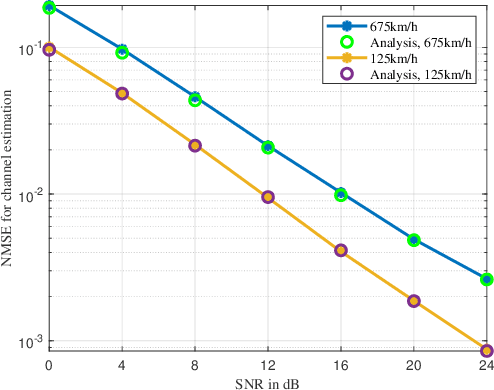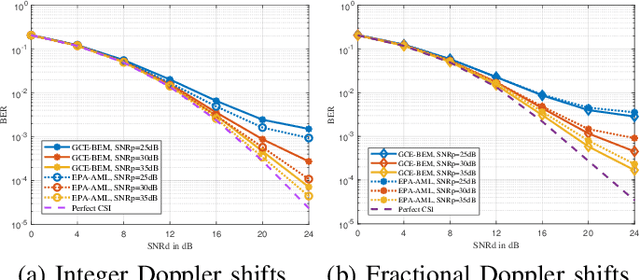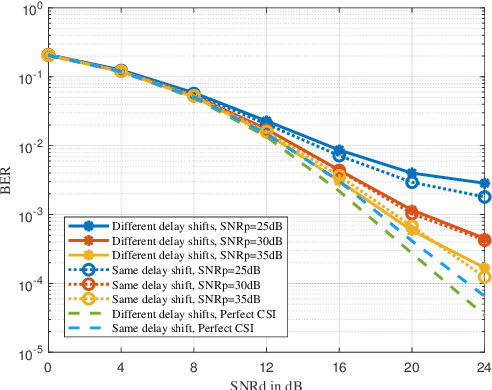Qihao Peng
Cluster-Aware Two-Stage Method for Fast Iterative MIMO Detection in LEO Satellite Communications
Jun 26, 2025Abstract:In this paper, a cluster-aware two-stage multiple-input multiple-output (MIMO) detection method is proposed for direct-to-cell satellite communications. The method achieves computational efficiency by exploiting a distinctive property of satellite MIMO channels: users within the same geographical cluster exhibit highly correlated channel characteristics due to their physical proximity, which typically impedes convergence in conventional iterative MIMO detectors. The proposed method implements a two-stage strategy that first eliminates intra-cluster interference using computationally efficient small matrix inversions, then utilizes these pre-computed matrices to accelerate standard iterative MIMO detectors such as Gauss-Seidel (GS) and symmetric successive over-relaxation (SSOR) for effective inter-cluster interference cancellation. Computer simulations demonstrate that the proposed method achieves more than 12 times faster convergence under perfect channel state information. Even when accounting for channel estimation errors, the method maintains 9 times faster convergence, demonstrating its robustness and effectiveness for next-generation satellite MIMO communications.
Dynamic Resource Allocation in Distributed MIMO-LEO Satellite Networks
May 27, 2025Abstract:This paper characterizes the impacts of channel estimation errors and Rician factors on achievable data rate and investigates the user scheduling strategy, combining scheme, power control, and dynamic bandwidth allocation to maximize the sum data rate in the distributed multiple-input-multiple-output (MIMO)-enabled low earth orbit (LEO) satellite networks. However, due to the resource-assignment problem, it is challenging to find the optimal solution for maximizing the sum data rate. To transform this problem into a more tractable form, we first quantify the channel estimation errors based on the minimum mean square error (MMSE) estimator and rigorously derive a closed-form lower bound of the achievable data rate, offering an explicit formulation for resource allocation. Then, to solve the NP-hard problem, we decompose it into three sub-problems, namely, user scheduling strategy, joint combination and power control, and dynamic bandwidth allocation, by using alternative optimization (AO). Specifically, the user scheduling is formulated as a graph coloring problem by iteratively updating an undirected graph based on user requirements, which is then solved using the DSatur algorithm. For the combining weights and power control, the successive convex approximation (SCA) and geometrical programming (GP) are adopted to obtain the sub-optimal solution with lower complexity. Finally, the optimal bandwidth allocation can be achieved by solving the concave problem. Numerical results validate the analytical tightness of the derived bound, especially for large Rician factors, and demonstrate significant performance gains over other benchmarks.
BEM-Assisted Low-Complexity Channel Estimation for AFDM Systems over Doubly Selective Channels
Apr 26, 2025



Abstract:In this paper, we propose a low-complexity channel estimation scheme of affine frequency division multiplexing (AFDM) based on generalized complex exponential basis expansion model (GCE-BEM) over doubly selective channels. The GCE-BEM is used to solve fractional Doppler dispersion while significantly reducing the computational complexity of exhaustive search. Then, the closed-form expression of channel estimation error is derived for the minimum mean square error (MMSE) estimation algorithm. Based on the estimated channel, the MMSE detection is adopt to characterize the impacts of estimated channel on bit error rate (BER) by deriving the theoretical lower bound. Finally, numerical results demonstrate that the proposed scheme effectively mitigates severe inter-Doppler interference (IDoI). Our theoretical performance an alysis can perfectly match the Monte-Carlo results, validating the effectiveness of our proposed channel estimation based on GCE-BEM.
Latency-Aware Resource Allocation for Integrated Communications, Computation, and Sensing in Cell-Free mMIMO Systems
Feb 24, 2025



Abstract:In this paper, we investigate a cell-free massive multiple-input and multiple-output (MIMO)-enabled integration communication, computation, and sensing (ICCS) system, aiming to minimize the maximum computation latency to guarantee the stringent sensing requirements. We consider a two-tier offloading framework, where each multi-antenna terminal can optionally offload its local tasks to either multiple mobile-edge servers for distributed computation or the cloud server for centralized computation while satisfying the sensing requirements and power constraint. The above offloading problem is formulated as a mixed-integer programming and non-convex problem, which can be decomposed into three sub-problems, namely, distributed offloading decision, beamforming design, and execution scheduling mechanism. First, the continuous relaxation and penalty-based techniques are applied to tackle the distributed offloading strategy. Then, the weighted minimum mean square error (WMMSE) and successive convex approximation (SCA)-based lower bound are utilized to design the integrated communication and sensing (ISAC) beamforming. Finally, the other resources can be judiciously scheduled to minimize the maximum latency. A rigorous convergence analysis and numerical results substantiate the effectiveness of our method. Furthermore, simulation results demonstrate that multi-point cooperation in cell-free massive MIMO-enabled ICCS significantly reduces overall computation latency, in comparison to the benchmark schemes.
Performance Analysis of BEM-based Channel Estimation for OTFS with Hardware Impairments
Feb 06, 2025



Abstract:This letter studies the low-complexity channel estimation for orthogonal time frequency space (OTFS) in the presence of hardware impairments. Firstly, to tackle the computational complexity of channel estimation, the basis expansion model (BEM) is utilized. Then, the mean square error (MSE) of the estimated channel is theoretically derived, revealing the effects of hardware impairments on channel estimation. Based on the estimated channel, the minimum mean square error (MMSE) detector is adopted to analyze the impacts of imperfect hardware on the bit error rate (BER). Finally, the numerical results validate the correctness of our theoretical analysis of the MSE for channel estimation and lower bound of the BER, and also demonstrate that even minor hardware impairments can significantly degrade the performance of the OTFS system.
Language Driven Occupancy Prediction
Nov 25, 2024



Abstract:We introduce LOcc, an effective and generalizable framework for open-vocabulary occupancy (OVO) prediction. Previous approaches typically supervise the networks through coarse voxel-to-text correspondences via image features as intermediates or noisy and sparse correspondences from voxel-based model-view projections. To alleviate the inaccurate supervision, we propose a semantic transitive labeling pipeline to generate dense and finegrained 3D language occupancy ground truth. Our pipeline presents a feasible way to dig into the valuable semantic information of images, transferring text labels from images to LiDAR point clouds and utimately to voxels, to establish precise voxel-to-text correspondences. By replacing the original prediction head of supervised occupancy models with a geometry head for binary occupancy states and a language head for language features, LOcc effectively uses the generated language ground truth to guide the learning of 3D language volume. Through extensive experiments, we demonstrate that our semantic transitive labeling pipeline can produce more accurate pseudo-labeled ground truth, diminishing labor-intensive human annotations. Additionally, we validate LOcc across various architectures, where all models consistently outperform state-ofthe-art zero-shot occupancy prediction approaches on the Occ3D-nuScenes dataset. Notably, even based on the simpler BEVDet model, with an input resolution of 256 * 704,Occ-BEVDet achieves an mIoU of 20.29, surpassing previous approaches that rely on temporal images, higher-resolution inputs, or larger backbone networks. The code for the proposed method is available at https://github.com/pkqbajng/LOcc.
Synchronization Scheme based on Pilot Sharing in Cell-Free Massive MIMO Systems
May 29, 2024



Abstract:This paper analyzes the impact of pilot-sharing scheme on synchronization performance in a scenario where several slave access points (APs) with uncertain carrier frequency offsets (CFOs) and timing offsets (TOs) share a common pilot sequence. First, the Cramer-Rao bound (CRB) with pilot contamination is derived for pilot-pairing estimation. Furthermore, a maximum likelihood algorithm is presented to estimate the CFO and TO among the pairing APs. Then, to minimize the sum of CRBs, we devise a synchronization strategy based on a pilot-sharing scheme by jointly optimizing the cluster classification, synchronization overhead, and pilot-sharing scheme, while simultaneously considering the overhead and each AP's synchronization requirements. To solve this NP-hard problem, we simplify it into two sub-problems, namely cluster classification problem and the pilot sharing problem. To strike a balance between synchronization performance and overhead, we first classify the clusters by using the K-means algorithm, and propose a criteria to find a good set of master APs. Then, the pilot-sharing scheme is obtained by using the swap-matching operations. Simulation results validate the accuracy of our derivations and demonstrate the effectiveness of the proposed scheme over the benchmark schemes.
Resource Allocation for Cell-Free Massive MIMO-aided URLLC Systems Relying on Pilot Sharing
Mar 21, 2023Abstract:Resource allocation is conceived for cell-free (CF) massive multi-input multi-output (MIMO)-aided ultra-reliable and low latency communication (URLLC) systems. Specifically, to support multiple devices with limited pilot overhead, pilot reuse among the users is considered, where we formulate a joint pilot length and pilot allocation strategy for maximizing the number of devices admitted. Then, the pilot power and transmit power are jointly optimized while simultaneously satisfying the devices' decoding error probability, latency, and data rate requirements. Firstly, we derive the lower bounds (LBs) of ergodic data rate under finite channel blocklength (FCBL). Then, we propose a novel pilot assignment algorithm for maximizing the number of devices admitted. Based on the pilot allocation pattern advocated, the weighted sum rate (WSR) is maximized by jointly optimizing the pilot power and payload power. To tackle the resultant NP-hard problem, the original optimization problem is first simplified by sophisticated mathematical transformations, and then approximations are found for transforming the original problems into a series of subproblems in geometric programming (GP) forms that can be readily solved. Simulation results demonstrate that the proposed pilot allocation strategy is capable of significantly increasing the number of admitted devices and the proposed power allocation achieves substantial WSR performance gain.
Resource Allocation for Cell-free Massive MIMO-enabled URLLC Downlink Systems
Feb 18, 2023Abstract:Ultra-reliable and low-latency communication (URLLC) is a pivotal technique for enabling the wireless control over industrial Internet-of-Things (IIoT) devices. By deploying distributed access points (APs), cell-free massive multiple-input and multiple-output (CF mMIMO) has great potential to provide URLLC services for IIoT devices. In this paper, we investigate CF mMIMO-enabled URLLC in a smart factory. Lower bounds (LBs) of downlink ergodic data rate under finite channel blocklength (FCBL) with imperfect channel state information (CSI) are derived for maximum-ratio transmission (MRT), full-pilot zero-forcing (FZF), and local zero-forcing (LZF) precoding schemes. Meanwhile, the weighted sum rate is maximized by jointly optimizing the pilot power and transmission power based on the derived LBs. Specifically, we first provide the globally optimal solution of the pilot power, and then introduce some approximations to transform the original problems into a series of subproblems, which can be expressed in a geometric programming (GP) form that can be readily solved. Finally, an iterative algorithm is proposed to optimize the power allocation based on various precoding schemes. Simulation results demonstrate that the proposed algorithm is superior to the existing algorithms, and that the quality of URLLC services will benefit by deploying more APs, except for the FZF precoding scheme.
Resource Allocation for Uplink Cell-Free Massive MIMO enabled URLLC in a Smart Factory
Nov 22, 2022



Abstract:Smart factories need to support the simultaneous communication of multiple industrial Internet-of-Things (IIoT) devices with ultra-reliability and low-latency communication (URLLC). Meanwhile, short packet transmission for IIoT applications incurs performance loss compared to traditional long packet transmission for human-to-human communications. On the other hand, cell-free massive multiple-input and multiple-output (CF mMIMO) technology can provide uniform services for all devices by deploying distributed access points (APs). In this paper, we adopt CF mMIMO to support URLLC in a smart factory. Specifically, we first derive the lower bound (LB) on achievable uplink data rate under the finite blocklength (FBL) with imperfect channel state information (CSI) for both maximum-ratio combining (MRC) and full-pilot zero-forcing (FZF) decoders. \textcolor{black}{The derived LB rates based on the MRC case have the same trends as the ergodic rate, while LB rates using the FZF decoder tightly match the ergodic rates}, which means that resource allocation can be performed based on the LB data rate rather the exact ergodic data rate under FBL. The \textcolor{black}{log-function method} and successive convex approximation (SCA) are then used to approximately transform the non-convex weighted sum rate problem into a series of geometric program (GP) problems, and an iterative algorithm is proposed to jointly optimize the pilot and payload power allocation. Simulation results demonstrate that CF mMIMO significantly improves the average weighted sum rate (AWSR) compared to centralized mMIMO. An interesting observation is that increasing the number of devices improves the AWSR for CF mMIMO whilst the AWSR remains relatively constant for centralized mMIMO.
 Add to Chrome
Add to Chrome Add to Firefox
Add to Firefox Add to Edge
Add to Edge